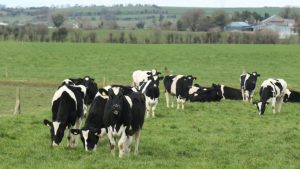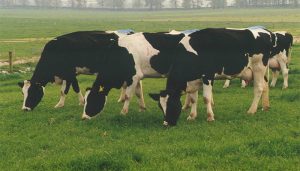
“Genomics will play a key role in this context,” he said.
“Issues that come to the fore in this context include the breeding of smaller cows. Ongoing development work at CAFRE is looking at the impact of reducing average cow liveweights down to 500kg.”
The CAFRE dairying specialist made these comments while addressing the 300 or more farmers attending the recent ARCZero farm walk, hosted by Thompson and Hugh Harbison.
The father-and-son team milk a herd of 180 crossbred autumn-calving cows at Aghadowey, Co. Derry. Significantly, they are committed to breeding a smaller cow type at the present time.
“Improving the overall efficiency of any farming enterprise will improve profitability while also acting to reduce carbon footprints,” Agnew continued.
“So farming for the environment really does represent a win-win scenario. In a dairying context, this means improving animal health standards; healthier animals are much more productive and less costly to keep.”
Other ways of reducing carbon footprint
The CAFRE representative stressed the benefits of calving heifers successfully at 24 months.
“Getting cows to remain in milking groups beyond the end of their second lactation is equally important,” he added. “There is no reason why a cow cannot remain within a herd until the end of her fourth or fifth lactation.
“Moving forward, there is also scope to increase the levels of grazed grass included in dairy cow diets.
“The end game is to achieve current levels of performance from a smaller resource base. When this is achieved the potential to plant out land that has been freed-up in trees, can become a reality,” he added.
New technologies
Those attending the open day were told that, where feed and slurry management are concerned, new technologies will soon deliver significant reductions in the carbon footprint associated with the use of these resources.
“Enteric methane is one of the largest greenhouse gas [GHG] emission sources on dairy farms,” Agnew continued.
“The coming years will see the availability of additives that will act to reduce the levels of feed-related methane production. One very obvious drawback is being able to use these products while animals are at grass.
“However, this issue is being addressed by an ongoing Teagasc research trial. The option of using inhibitor boluses is an option showing considerable promise at the present time.
“Slurry represents an important resource on all livestock farms. It should be applied to land using low emission spreading equipment [LESS].”
He also explained to those gathered for the open day that denitrification inhibitors will soon be available that will act to enhance the nitrogen fertiliser value of slurries.
“All fertilisers, chemical and organic, should be spread at rates dictated by the results of an up-to-date soil test,” he stated.
“Soil compaction will act to increase carbon footprint values. Research has shown that addressing soil compaction issues will serve to improve the utilisation of fertilisers by up to 20%.”

























